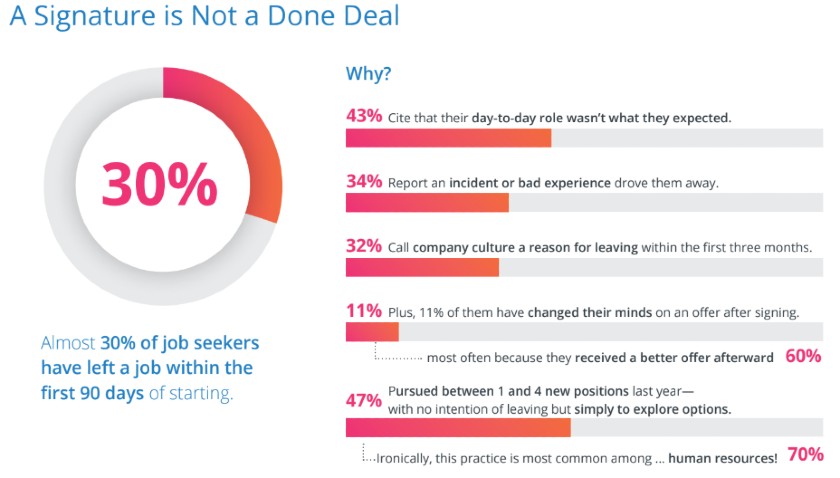
Hiring decisions are one of the most important tasks for HR professionals. Businesses that are successful in these decisions are able to reap the benefits of attracting high quality applicants who are not only technically skilled for the role, but also possess qualities that make them a good fit for the work environment.
This alignment can lead to increased productivity, profitability and employee satisfaction. However, making a bad hiring decision can cost time, money and the company’s reputation.
Here are 7 factors that need to be considered when recruiting to avoid bad hiring decisions:
1. Up-to-date job analysis
Prior to posting a job advertisement, you should ensure that you have identified all the important tasks of the job, as well as the type of characteristics that your new hire should possess in order to successfully perform in the role.
This is especially important if it has been a while since you have had to hire an individual for this role, as duties and tools used to complete the job may have evolved over time.
Having an up-to-date job analysis will help to determine which type of screening evaluations to include in the selection process, which will then ensure that you are hiring the right person for the role.
Research has even found that companies that have formal job analyses in place perform better than those who do not, in terms of greater financial performance and employee productivity, as well as lower employee turnover. So, try not to overlook this step!
2. Define clear expectations
Once you have identified the job description and person specifications via the job analysis, it is important to be as transparent as possible about these in the job advertisement.
Some recruiters believe that in order to attract a large applicant pool, they should inflate their job advertisements to make them as enticing as possible.
However, this approach will only lead to issues later on, as applicants may become more aware of the actual expectations further down the recruitment process and decide to withdraw their application.
Alternatively, the applicant may not realise the reality of the role until they have already been hired. This can lead to them quitting soon after because the expectations had not been clearly outlined to them from the beginning.
A 2018 US study found that 30% of candidates left a job within the first 90 days of working there, with 43% reporting that their day-to-day role was not what they expected it to be.
Therefore, being as upfront and transparent as possible about your expectations at the beginning of the recruitment process will ensure that only those who are truly interested in the role will apply, as well as reducing new-hire turnover rates.

3. Streamline your application process
The applicant’s experience throughout the recruitment process is often overlooked, however it is an important factor to finding the right candidate for the job.
Another US study conducted found that 42% of applicants would drop out of the application process if the application was too difficult or confusing to complete. Furthermore, 31% of applicants would drop out of the application if it took too long to complete.
According to Glassdoor, traditional job applications take over 30 minutes to complete and often ask for excessive information from candidates. Applicants hate when they are asked to re-enter their employment history after already uploading their resume file, and with today’s available technology, this type of application process is outdated and unnecessary!
Best not to ask for a resume at all!
Keep your initial application process simple and short, and leave the more personal/in depth questions to the interview stage. Incorporating AI solutions such as applicant tracking or predictive hiring can streamline this process by providing the most relevant screening questions that can actually predict future job performance.
Applicants know that their time is valuable, so simplifying your application process will ensure that the best candidates are applying for your advertised roles.
4. Hard skills and soft skills
First and foremost, when recruiting new staff, it is essential that the applicants’ hard skills are assessed. Hard skills are the technical skills, capabilities or education that an employee must possess in order to successfully perform the role.
If you’re hiring a doctor, you want to know that they are qualified and licenced to practice medicine! Every job will have a different set of hard skills that are necessary to be successful in the role.
However, insights from McKinsey have found that companies are often too focused on assessing prior experience and hard skills to measure a candidate’s potential performance.
This research found that a candidate’s soft skills, such as their personality and interpersonal skills, can contribute to up to 5 to 20 percent variance in job performance, while past experience was not a predictor of job success.
For example, McKinsey found that when recruiting sales associates, focusing on a candidate with prior sales experience did not predict their performance on the job.
Instead, hiring based on a candidate’s levels of resilience and ability to work in unstructured environments, and then creating a training program to fill the gaps in their experience, predicted better job performance.
Certain roles will require a candidate to possess specific hard skills, however, attitude and character cannot be trained! An applicant’s soft skills should not be overlooked in the hiring process.
In some cases, it will be best to hire the applicant with the most potential and relevant soft skills, then train them up to possess the hard skills for the role.
5. Culture fit
The importance placed on organisational culture has increased exponentially over the years, with 77% of applicants now considering a prospective employer’s workplace culture before applying for a role.
On top of this, 56% of adults believe that workplace culture is more important than salary when it comes to job satisfaction. As such, having a brief description of the type of culture your candidates can expect to be a part of in your job ad can help to ensure you are acquiring applicants with a good cultural fit for your vacancy.
However, job seekers should not be the only people concerned with cultural fit. As the hiring manager, this should be a priority to you too! Research suggests that organisational culture is linked to higher financial performance and customer satisfaction within firms.
On top of this, a 2018 US survey found that 32% of new hires quit within the first 90 days of employment citing a poor culture fit as their reason for leaving.
In order to avoid this from happening, it is best to assess a candidates cultural fit during the recruitment process. This is where personality testing and behavioural interview questions can be useful.
These tools can provide information on the candidate’s character and values, which will help to identify those who will be a good match for the department they will be hired into, as well as for the company overall.
6. Employee Value Proposition
While clearly outlining what is expected of the potential employee is critical during the recruitment phase, it should not stop there! Just as critical is outlining what the employee can expect in return for their hard work within your company.
In a survey conducted by Glassdoor, 50% of job seekers reported that a lack of information about pay and benefits was their biggest frustration when job searching. However, in today’s competitive job market, businesses need to think outside the box when creating their employee value proposition.
The employee value proposition is not simply about outlining the salary package that the potential recruit can expect, it should also include the intrinsic rewards that the employee will experience if they choose to apply for your role.

Most employers believe that a higher salary will motivate new candidates to apply, and current employees to stay in their roles.
While this may reign true for some, insights from McKinsey have highlighted that higher and more frequent financial incentives are not actually correlated to performance.
Instead, opportunities for career advancement and positive workplace culture are what motivate performance.
On top of this, a survey conducted by Deloitte found that the benefits that employees value most include flexible working arrangements, learning and development, health and wellbeing benefits and the ability to complete work that is meaningful to them. Today’s workforce views rewards as more than just money.
Therefore, in order to gain competitive edge and attract high quality applicants, this should be taken into consideration when developing your employee value proposition!
7. Employer Brand
Your employer brand is comprised of your company’s mission and how your current and future employees perceive your business. Having a strong employer brand is crucial for attracting high quality applicants, or any applicants at all!
If your company has a bad reputation for how they treat their staff, there is a good chance that job seekers will not wish to apply, as 69% of applicants take the company’s brand into important consideration when evaluating a job offer.
The employer brand is also important in terms of staff retention, as the main reason that 64% of employees stay in their roles is attributed to their alignment to their employer’s mission.
A major factor to consider in terms of your employer brand during the recruitment phase, is how you treat your applicants (all of them!).
Many businesses treat their applicants as though it is a privilege to be considered for a role within their company. This impersonal treatment can lead to drastic spillover effects that can impact your employer brand in the future.
For example, if a disgruntled candidate tells others (such as potential customers of your business) about their negative recruitment experience with you, this could lead to spillover effects such as decreased organisational performance (as customers may choose to abandon your business) and being unable to effectively attract new applicants in the future.

The best way to maintain your employer brand during the recruitment process is to treat all applicants with dignity and respect.
This can be as simple as sending out automated emails thanking them for their time and application, and informing them if they will not be considered for the role.
The best way to maintain your employer brand during the recruitment process is to treat all applicants with dignity and respect. This can be as simple as sending out automated emails thanking them for their time and application, and informing them if they will not be considered for the role.
Ignoring your unsuccessful applicants will deter them from wanting to apply for a different role within your company in the future. This will decrease your available Talent Pool for future roles that these candidates may have been better suited for, which is the opposite of what effective hiring aims to achieve!
And have you considered how many of these unsuccessful applicants are your customers or potential customers?
By taking these 7 steps into consideration when undertaking your recruitment process, you will be able to ensure that your efforts are productive in attracting and retaining high quality applicants and employees, who are not only technically skilled for the role, but also possess qualities that make them a good fit for the work environment within your company.
On top of this, you will keep your strong employer brand intact, which will help in future hiring efforts!


